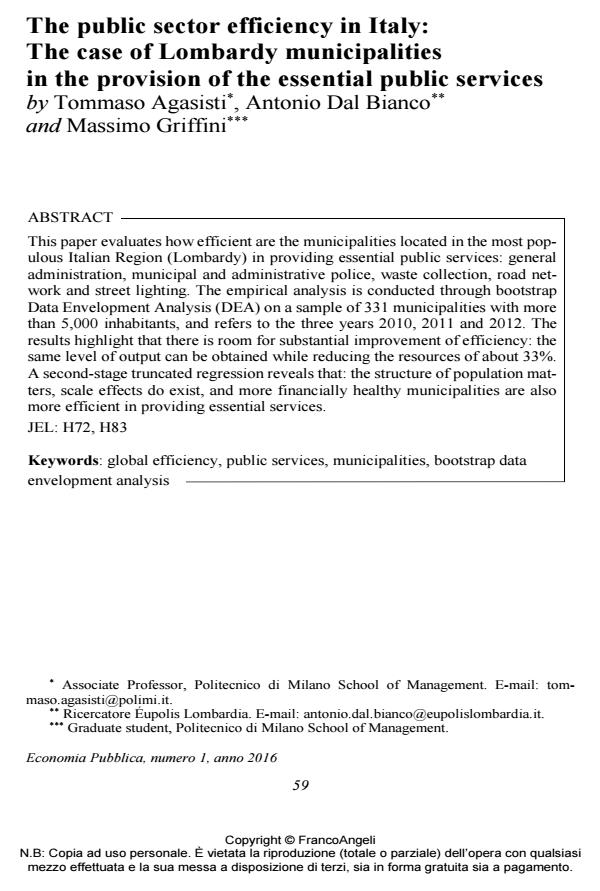The public sector efficiency in Italy: The case of Lombardy municipalities in the provision of the essential public services
Titolo Rivista ECONOMIA PUBBLICA
Autori/Curatori Tommaso Agasisti, Antonio Dal Bianco, Massimo Griffini
Anno di pubblicazione 2016 Fascicolo 2016/1
Lingua Italiano Numero pagine 26 P. 59-84 Dimensione file 375 KB
DOI 10.3280/EP2016-001004
Il DOI è il codice a barre della proprietà intellettuale: per saperne di più
clicca qui
Qui sotto puoi vedere in anteprima la prima pagina di questo articolo.
Se questo articolo ti interessa, lo puoi acquistare (e scaricare in formato pdf) seguendo le facili indicazioni per acquistare il download credit. Acquista Download Credits per scaricare questo Articolo in formato PDF

FrancoAngeli è membro della Publishers International Linking Association, Inc (PILA)associazione indipendente e non profit per facilitare (attraverso i servizi tecnologici implementati da CrossRef.org) l’accesso degli studiosi ai contenuti digitali nelle pubblicazioni professionali e scientifiche
This paper evaluates how efficient are the municipalities located in the most populous Italian Region (Lombardy) in providing essential public services: general administration, municipal and administrative police, waste collection, road network and street lighting. The empirical analysis is conducted through bootstrap Data Envelopment Analysis (DEA) on a sample of 331 municipalities with more than 5,000 inhabitants, and refers to the three years 2010, 2011 and 2012. The results highlight that there is room for substantial improvement of efficiency: the same level of output can be obtained while reducing the resources of about 33%. A second-stage truncated regression reveals that: the structure of population matters, scale effects do exist, and more financially healthy municipalities are also more efficient in providing essential services
Parole chiave:Global efficiency, public services, municipalities, bootstrap data
Jel codes:H72, H83
- Global public spending efficiency in Tuscan municipalities Giovanna D'Inverno, Laura Carosi, Letizia Ravagli, in Socio-Economic Planning Sciences /2018 pp.102
DOI: 10.1016/j.seps.2017.01.006 - Advances in Local Public Economics Calogero Guccio, Domenico Lisi, Marco Martorana, pp.233 (ISBN:978-981-13-3106-0)
- Local government efficiency: reviewing determinants and setting new trends Juan Milán‐García, Nuria Rueda‐López, Jaime De Pablo‐Valenciano, in International Transactions in Operational Research /2022 pp.2871
DOI: 10.1111/itor.13032 - Local government efficiency and economic growth: The Italian case Francesco Perugini, in Socio-Economic Planning Sciences 101775/2024 pp.101775
DOI: 10.1016/j.seps.2023.101775 - Local governments' efficiency: a systematic literature review—part I Isabel Narbón‐Perpiñá, Kristof De Witte, in International Transactions in Operational Research /2018 pp.431
DOI: 10.1111/itor.12364 - Equitable and sustainable well-being in Italian municipalities: Do women in politics make the difference? Barbara Ermini, Raffaella Santolini, Mariateresa Ciommi, in Socio-Economic Planning Sciences 101741/2023 pp.101741
DOI: 10.1016/j.seps.2023.101741 - Female presence in local government and cost efficiency: the case of Italian municipalities Valeria Bucci, Giancarlo Ferrara, Giuliano Resce, in Regional Studies /2024 pp.16
DOI: 10.1080/00343404.2023.2186386 - Stewardship and administrative capacity in green public procurement in the Czech Republic: evidence from a large-N survey Michal Plaček, Vladislav Valentinov, Cristina del Campo, Gabriela Vaceková, František Ochrana, Markéta Šumpíková, in Environmental Sciences Europe 94/2021
DOI: 10.1186/s12302-021-00534-7 - Efficiency of local public spending in Cameroon: Does population size matter? Bruno Emmanuel Ongo Nkoa, Djondandi Wangbara, Gautier Tchoffo Tameko, in African Development Review /2024 pp.362
DOI: 10.1111/1467-8268.12764 - Local governments’ efficiency and educational results: empirical evidence from Italian primary schools Simona Ferraro, Tommaso Agasisti, Francesco Porcelli, Mara Soncin, in Applied Economics /2021 pp.4017
DOI: 10.1080/00036846.2021.1896672 - Narrowing the gap: Dynamics of Indonesia's public expenditure performance in economically lagging districts Ardi Sugiyarto, Boon L. Lee, Clevo Wilson, in Economic Analysis and Policy /2025 pp.2299
DOI: 10.1016/j.eap.2025.03.014 - Spatial directional robust Benefit of the Doubt approach in presence of undesirable output: An application to Italian waste sector Elisa Fusco, Francesco Vidoli, Nicky Rogge, in Omega 102053/2020 pp.102053
DOI: 10.1016/j.omega.2019.03.011 - Fiscal Decentralization Reforms Michal Plaček, František Ochrana, Milan Jan Půček, Juraj Nemec, pp.199 (ISBN:978-3-030-46757-9)
- Local governments’ efficiency and its heterogeneity – empirical evidence from a stochastic frontier analysis of Italian municipalities 2010-2018 Tommaso Agasisti, Francesco Porcelli, in Applied Economics /2023 pp.2902
DOI: 10.1080/00036846.2022.2107988 - Fiscal Decentralization Reforms Michal Plaček, František Ochrana, Milan Jan Půček, Juraj Nemec, pp.1 (ISBN:978-3-030-46757-9)
- The municipalities efficiency in Israel: The case of the provision of educational services Yifat Betser-Nahum, Iris BenDavid-Hadar, in International Journal of Educational Development 103370/2025 pp.103370
DOI: 10.1016/j.ijedudev.2025.103370 - Actual Autonomy, Efficiency and Performance of Universities: Insights from the Russian Case Tommaso Agasisti, Ekaterina Shibanova, in International Journal of Public Administration /2022 pp.121
DOI: 10.1080/01900692.2021.1903496 - EXPLAINING DIFFERENCES IN EFFICIENCY: A META‐STUDY ON LOCAL GOVERNMENT LITERATURE Francesco Aiello, Graziella Bonanno, in Journal of Economic Surveys /2019 pp.999
DOI: 10.1111/joes.12310 - Electoral rule and public sector efficiency: Some evidence from Italian municipalities Marco Alberto De Benedetto, Sergio Destefanis, Luigi Guadalupi, in Journal of Regional Science /2024 pp.176
DOI: 10.1111/jors.12669 - The Role of Women in Local Governments: An Analysis of Efficiency in Spain Ana-María Ríos, María-Dolores Guillamón, Beatriz Cuadrado-Ballesteros, in Urban Affairs Review /2023 pp.1013
DOI: 10.1177/10780874221113217 - Advances in Efficiency and Productivity II José Manuel Cordero, Carlos Díaz-Caro, Cristina Polo, pp.221 (ISBN:978-3-030-41617-1)
Tommaso Agasisti, Antonio Dal Bianco, Massimo Griffini, The public sector efficiency in Italy: The case of Lombardy municipalities in the provision of the essential public services in "ECONOMIA PUBBLICA " 1/2016, pp 59-84, DOI: 10.3280/EP2016-001004